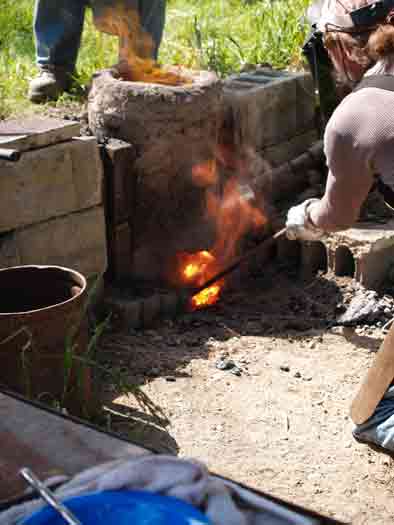Answer : Quite poorly - to its destruction!
Long time readers know that my team here from DARC is working towards a full scale re-construction of an Icelandic styled iron smelter, based on Kevin Smith's excavations at Hals (from the Viking Age)
An interesting piece of the puzzle was seen this spring, when the snow finally came off here in Wareham. Now admittedly this is Central Ontario, and this winter was unusual. There were at least three separate snow dump and thaw cycles this year. Almost much snow as a typical year came down from early November through to mid December, followed by a thaw that melted most of the ground cover off just after Christmas. This was repeated in January, with a finial dump which is still not totally melted at the point I am writing this in Mid April.
The result is even more freeze and thaw damage than is typical, and the two smelters still standing in our working area clearly demonstrate this. Both were covered with a metal drum to prevent direct rain damage, and to prevent snow from filling the shaft.
First is one of our standard 'Norse Short Shaft', furnaces, half earth banked. This furnace was built and fired in early October last fall. The first image shows the rough condition of the structure at the start of the bottom extraction process. The second shows considerable spalling off of the front wall as winter damage. I estimate that the furnace has lost almost 50% of its thickness of about 8 cm. It should prove possible however, to simply patch and continue to use this furnace, as there is virtually no damage at all to the inner, sintered, surface of the shaft.
 |  |
Compare this to the condition of the Icelandic pattern furnace, built and fired in early November last fall (and set about five feet from the other one).
This furnace has walls only 3 cm thick roughly 1/3 as thick as the other smelter. When the furnace was used, the whole exposed front face was badly cracked, so it was decided to simply remove the segment above the bellows plate and tap arch when measurements were being made (image to left). Over the winter, the entire structure disintegrated, and the soil surrounding the cylindrical shaft has slumped into the resulting hole (image to right). The circle of stones originally surrounding the top of the shaft have come to rest on a layer made up of broken, sintered furnace wall from the upper part of the shaft (image at centre).
 |  |  |
The supporting structure at Halls was made up of stacked layers of grass sod, which certainly would have been more stable than the loose earth backing used for our initial test furnaces. The fact remains that the thin clay cobb lining, at best partially sintered, would be unlikely to survive the riggors of an Icelandic winter. This may have a bearing on the remains found at Hals, since at the very least it suggests an individual furnace structure would only prove usable, without heavy rebuilding, for any more than a single summer season.




















1 comment:
Great information.
I think I read somewhere, maybe National Geographics, that the Vikings made many temporary settlements for the express purpose of harvesting bog iron and smelting it. That might explain the "This is good enough for one season" archaeological finds.
But then again, what do I know!
Regards,
Albert
The Rasch Outdoor ChroniclesThe Range Reviews: TacticalProud Member of Outdoor Bloggers Summit
Post a Comment